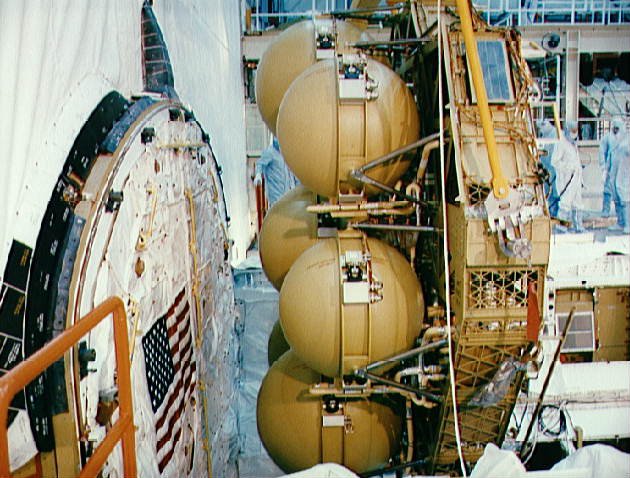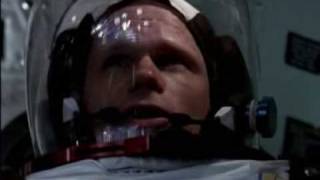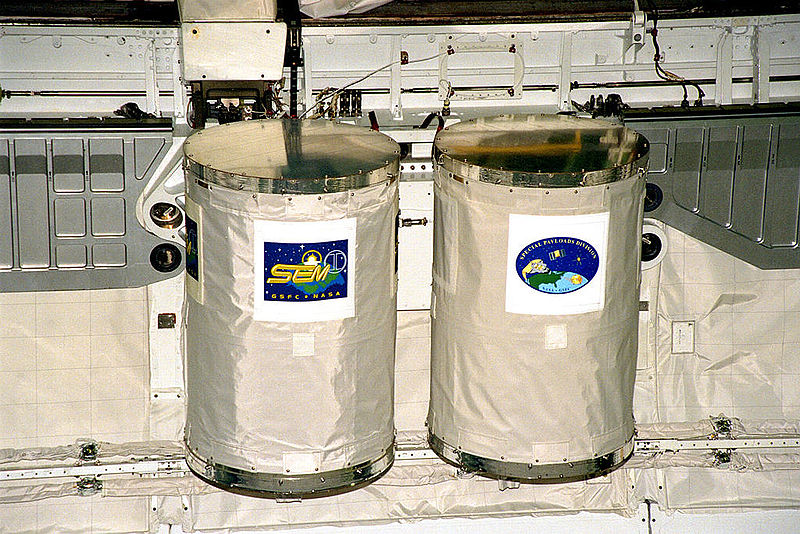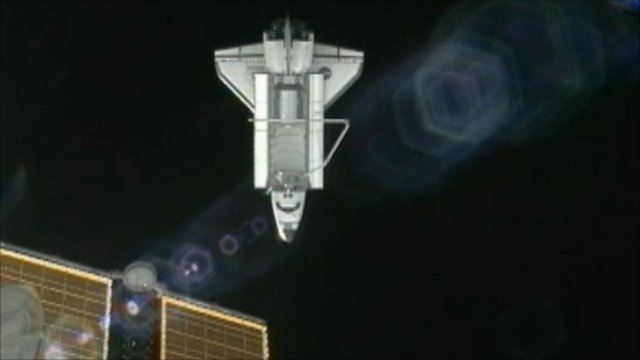More apt to be frozen, really. I have a vague memory that equilibrium temperature of a tank in LEO is something close to LOX's storage temperature, so about -190 C. The cookies might be a bit chilly!

Reading Lost Moon and remembering that Ron Howard's movie got that technical detail right (the astronauts were freezing, not roasting--there were other details Lovell, in the DVD commentary, pointed out were wrong but on the whole Howard tried to get it right, with Lovell's personal technical assistance) of course this is correct, unless the transit time is just too fast for them to chill down much. I really don't understand why this is; sunlight is generally shining on everything in orbit, with night shadow being less than half the time, whereas radiation of heat is not as good at removing heat as physical contact bringing about conduction and convection. The sunlight is brighter than anything we ever see on Earth even in a bone-dry desert at summer high noon; everything ought to get good and hot and need to be hot to radiate away the incoming heat, whereas when it is in shadow the cooling should slow down a lot as it gets colder.
And yet there they were, Lovell, Haise and Swiggert, shivering away in their powered down Apollo even though they were good and far from Earth most of the time and hardly ever in shadow. Weird, but apparently true.
Clearly you mention LEO because it would be even chillier, with everything being in darkness half the time.
... However, what I do know is that the fuel cell stack and associated tanks were located in the space between the bottom of the payload bay and the belly of the orbiter.
I got that from the
NSTS 1988 News Reference Manual...
You're talking about really getting into the guts to get to those...
So, yeah, getting at the main tanks is pretty much out of the question.
But the verbal description did not make it clear how difficult it would be!

Considering that the manual said that not all missions would even require 3 pairs of tanks and they therefore could be removed or added as needed I guess I figured they'd make it easy on themselves and just have a swing-back panel behind which the tanks were secured with a few easily loosened brackets--six turns of the wrench, swing the old tanks out, snap the new ones in, check the gas line connections, put back the retainers and tighten the bolts and there you are. Evidently not.

The one thing that is beneficial is that Columbia was carrying the EDO (Extended Duration Orbiter) pallet, as seen here, which was a set of additional tanks to enable the 16-day flights that they were doing. ...That might be an easier place to tap the lines if they were going to--but I'm not convinced it's doable on-orbit. As far as how long Columbia has...16 days at nominal power is the capability of the orbiter with the EDO pallet. They don't power down in Archibald's TL until Flight Day 5, and are at 9.4 kW from then on. Nominal power draw was 21 kW, so that means they have 2.2x the duration that they otherwise would have had. So, doing a little rough math, 4 days at full power leaves the equivalent of 12 days at full power left, which then translates to 26.8 days at 9.4 kW. So the power will run out on Flight Day...31. February 14. Convenient, so they'll suffocate, starve, and run out of power all on the same day...I don't know if it's possible to patch in the solar arrays of Eureca or Intelsat into the Orbiter's systems, but it seems like they have to try unless Atlantis can be on-orbit by Feb 14--otherwise they'll be stuck seeing how well the wing patch holds.

Given that the EDO gave about 5 days extra duration at nominal 21 kW from about 1584 kg of cryogens (11 days at 9.4 kW) stored in 1600 kg of tanks, I'm not sure it's practical at all to try and ship up more fuel cell reactants on Eureca's mere 1 ton--and if you can't, then shipping food and LiOH filters is rather pointless, since you'll be out of power. If only you had more mass...
I was afraid the numbers would work out like that, and I wasn't even aware that the EDO was involved.
If they can't feed new reactants in at the EDO junction, then in addition to reactants they'd have to ship up two new fuel cells (and that assumes that the electrical lines can be patched into, which might be no easier than patching in the gas lines). Two, because one cell maxes at 7 kw sustained whereas they need 9.4.
I did dredge up what a standard oxy and hydrogen tank mass
upthread. 717 kg for a single pair of standard tanks. I guess that's about enough for 4-5 days at 9.4 KW.
OTOH--it's kind of suspicious that the power runs out just when the LiOH canisters were expected to. It makes me think that perhaps 9.4 KW was not the absolute bare minimum power needed to run the ship after all, but rather a compromise designed to last just long enough for Atlantis to get there. Which implies they could have been saving even more power and stretching the tanks longer; it would mean less water per day but I think they were well above the minimums there. Clearly if that's the case the more extreme power-down should have been ordered much earlier, at the latest when Atlantis's launch schedule slipped.
So a single pair of tanks, massing most of Archibald's decreed one tonne limit, might last them considerably longer, especially if they'd been saving more power in the interim month. Say the tanks add a week, to another week added by prior power savings, the canisters to last two weeks could fill out the load. No room for cookies!
Or as you say--alas that it's just one tonne, and why is it so limited when the rocket could launch 7 of them? I assumed of course Eureca was the only game in town, or Archibald would not be wishing it on us, but it never made sense to me its cargo load would be so very limited. The Intelsat does indeed look like it might have been better--if you say so; I never imagined that a comsat could be converted into a cargo bus, I figured it would be an integral mass of microelectronics with a minimal engine and fuel stuck on.
With several tonnes, the air and power supply could clearly be stretched out for weeks, weeks that apparently might be needed.
Two new fuel cells, designed to be accessible, would mass another quarter tonne, but if we can get well beyond a measly single tonne, they are clearly doable. Send up two tonnes, in the form of two pairs of tanks (1434 kg) and a couple of spare fuel cells (300 kg, with cables and hoses for the water and such) and we still have a couple hundred kg for cookies, veggies, letters etc. Oh and the LiOH canisters, sorry about the cookies but with all this they can live another couple weeks.
It is still true that Columbia has avoided the need to use up orbital maneuvering propellant to chase Eureca down. If someone can find another rocket and lash together another cargo bus, Columbia still has those reserves to go get it.
But, since the load up on Archibald's canon Eureca did not include another hydrogen tank (and those are much less massive than oxygen tanks, so I have to cry, "why, God, why?"

) the power is about to go out, long before another rocket could reach them if it was sitting on the pad ready to go this very minute!
I really hate to call for a retcon, Archibald, but then that's why I've been harping on the power situation for the past couple weeks, so that you wouldn't have to. Now we know, and had the information to figure out some time ago--we needed to verify that they couldn't cut the power draw down more and I strongly suspect they might have; we know that some supplemental power supply had to go up (bearing in mind e of pi's reservations about being able to patch new tanks in even at the EDO, but it looks open to me and there has to be some intakes in the main ship structure to pipe the EDO's supplied gases over to the cells, so I'd think just patch the new tanks in there) and that being limited to a tonne was as futile as it looked to me when you first mentioned it and I protested. Maybe it could have been done under a tonne, buying them half a week anyway. Without the hydrogen tank it's hopeless though!
They look bloody well doomed right now, unless you've got an unmentioned rabbit to pull out of your hat.
Please say it's so, or edit something somewhere. Cut the power draw they've been drawing the past few weeks, that would be easiest. But there must be some minimum below which crucial systems can't work and might not come back from. Include a hydrogen tank in the tonne; make it more than a tonne.
That or the unimagined rabbit--please?














